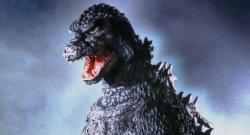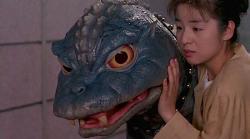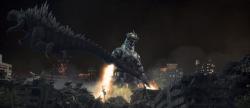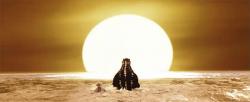Reviews
San Daikaijū: Chikyū Saidai no Kessen / Ghidrah, the Three-Headed Monster
Ishirō Honda
Japan, 1964
Credits
Review by Tina Hassannia
Posted on 05 February 2013
Source Netflix VOD
Categories The Compleat Godzilla
King Ghidorah is an unusual beast within a sci-fi series brimming with monsters. Whilst other kaiju have been traditionally imbued with a human sensibility - creatures who, despite their predilection in causing mass catastrophe, still invoke a genuine curiosity and respect from human characters - Ghidorah comes from space, and is thus unknowable, without feeling. He may have three heads, but he is faceless. Ghidorah is also unique in that he is more deadly than the earth-dwelling kaiju. His arrival on Earth - after exploding from within a strangely magnetic meteorite - comes at a time of great cosmological unrest. In Japanese wintertime, the temperature has risen to summer highs; meanwhile, an abundance of stars are spotted shooting around the world, and a strange woman who claims to be from Venus - a Princess from a fictional country who is under an alien’s trance - correctly predicts volcanic eruptions and the re-emergence of Godzilla and Rodan. The intuitive and wise Shobijin fairies from Infant Island believe her when she predicts Ghidorah’s strength in destroying the world. The Venusian cautions that Ghidorah ruined her civilization and planet, and will do the same to Earth. Thus, it’s up to Mothra to convince Godzilla and Rodan (themselves in battle with each other) to join her in defeating the three-headed space monster.
The subsequent parley between the kaiju comes off as fairly silly - it’s a significant, climactic moment and yet consists of little more than a moth squeaking at an obstreperous lizard and bird, with their conversation translated by the Shobijin fairies - but it’s also a germane strategy considering the series’ overarching theme of anthropomorphization and Toho’s ratification of its youth demographic. By the time of Ghidorah’s release, Godzilla was an international cultural icon; for children, he was a beloved creature perfect for toys and merchandising. Ghidorah continued the trend of not only anthropomorphizing the kaiju but treating them as real characters with motivations and nascent backstory. What ultimately compels Godzilla and Rodan to help Mothra beat Ghidorah is not a sense of obligation to save humanity - which they believe is against them, anyhow - but a sense of saving their homeland, the Earth. It’s an unlikely and awkward alliance, but it’s testament to one of the series’ traditionally trademark themes: Godzilla must always exist in relation to humans, and their relationship is a conflicting but necessary symbiosis between man and beast.
The independence and tenacity of Ghidorah’s female characters mark the film’s most fascinating elements, particularly noticeable in lead character Naoko, a journalist who beats her colleagues to the scoop in finding the Venusian, whose predictions are one by one coming true. Naoko is the series’ first real heroine, with a resilient independence that has her unbound by relationships to male characters (including her overprotective brother). In fact, she dismisses her family’s insistence that her friend, a professor studying the Ghidorah meteorite, is also her boyfriend. He is simply an acquaintance that can help her land a story, as she values her own career above else. Indeed, her open-mindedness leads her to ask the right questions to the Venusian and the Shobijin fairies that help to uncover the truth about Ghidorah. This particular scene, set in a hotel room - intended to establish exposition about the invincibility of the three-headed monster - is an integral, pivotal point in the narrative. It’s interesting that despite the convenient grouping of the female characters in these closed quarters, the Communist spies sent to assassinate the Princess and who have been stalking the hotel room, are treated like distractions in scenes such as this one (easily tricked by the Shobijin fairies) rather than operating like the James Bond-like villains they so clearly imitate.
Despite some basic incongruities and its occasionally silly tone, Ghidorah, the Three-Headed Monster is a genuinely enjoyable film for the series. The multiplicity of narrative threads, initially off-putting and somewhat confusing, gains momentum and strong continuity by the film’s second half. Ghidorah is a spectacular progression in monster special effects construction, particularly noticeable during the epic four-monster brawl which finally scares off the space monster, who flies away in shame—for now. For the first time ever, the kaiju have saved the day.
More The Compleat Godzilla
-

Godzilla
1954 -

Godzilla Raids Again
1955 -

King Kong vs. Godzilla
1962 -

Mothra vs. Godzilla
1964 -

Ghidorah, the Three-Headed Monster
1964 -

Invasion of Astro-Monster
1965 -

Ebirah, Horror of the Deep
1966 -

Son of Godzilla
1967 -

Destroy All Monsters!
1968 -

All Monsters Attack
1969 -

Godzilla Vs. Hedorah
1971 -

Godzilla vs. Gigan
1972 -

Godzilla vs. Megalon
1973 -

Godzilla vs. Mechagodzilla
1974 -

Terror of Mechagodzilla
1975 -

The Return of Godzilla
1984 -

Godzilla vs. Biollante
1989 -

Godzilla vs. King Ghidorah
1991 -

Godzilla vs. Mothra
1992 -

Godzilla vs. Mechagodzilla
1993 -

Godzilla vs. SpaceGodzilla
1994 -

Godzilla vs. Destoroyah
1995 -

Godzilla 2000
1999 -

Godzilla vs. Megaguirus
2000 -

Godzilla, Mothra and King Ghidorah: Giant Monsters All-Out Attack
2001 -

Godzilla Against Mechagodzilla
2002 -

Godzilla: Tokyo S.O.S.
2003 -

Godzilla: Final Wars
2004
We don’t do comments anymore, but you may contact us here or find us on Twitter or Facebook.



